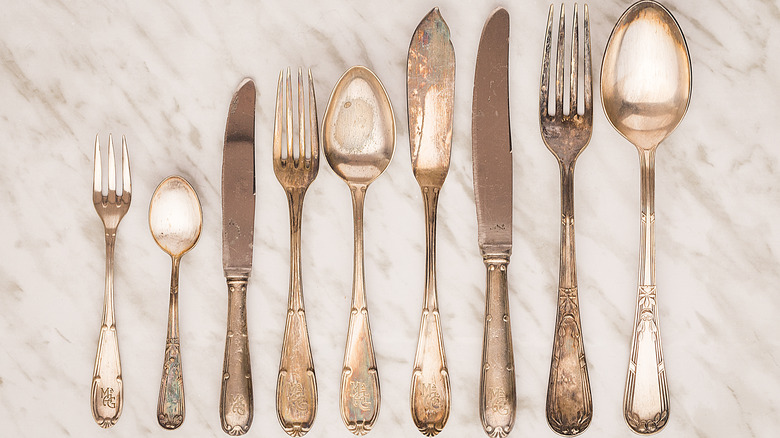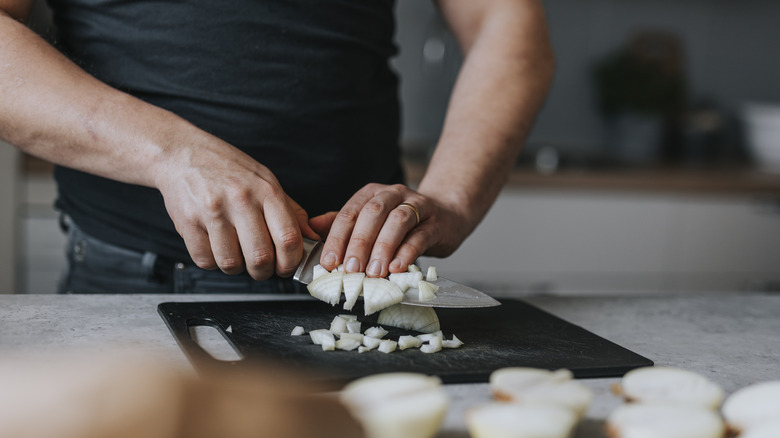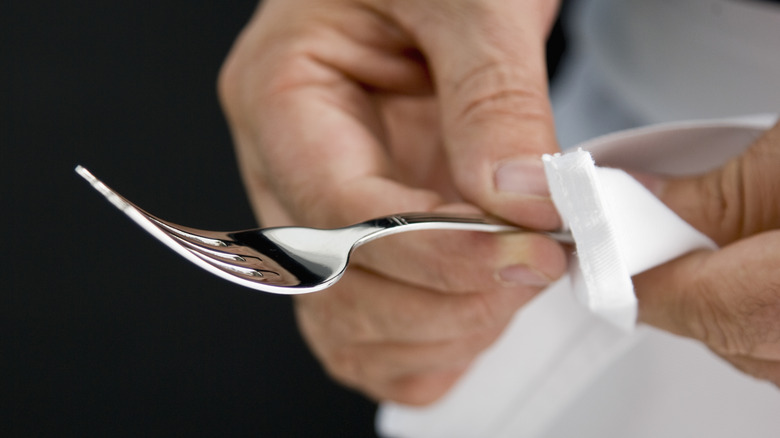The Common Ingredients That Might Be Damaging Your Sterling Silver Flatware
Some people who own a set of sterling silver flatware tend to keep it bundled safely away for special occasions only, out of fear of damaging it with use. Silver does require more upkeep than other kinds of flatware, like stainless steel. But it's fine to use it every day with precautions and proper care. Notably, some common ingredients can damage sterling silver flatware if they stay on it for too long, such as eggs and onions. Thankfully, the damage isn't irreversible.
Sterling silver is an alloy, typically made by mixing silver with a small amount of copper to make it more durable and hard. It's also known as 925 silver because it contains 92.5% pure silver. Its copper content means that it tarnishes more easily than pure silver. It's hard to completely keep silver from tarnishing unless you never use it at all, but that's defeat the purpose of owning the shiny flatware. Here's why some foods tarnish sterling silver, how to prevent it, and what to do if it happens.
Sulfur-rich ingredients can tarnish silver
Silver tarnishes when it reacts with sulfur-containing gases in the air, causing the metal to discolor, fade, or darken. The copper in sterling silver reacts with those same gases as well, which is why it's more vulnerable to tarnishing than pure silver. Just being exposed to the air can cause tarnishing over time, but directly touching ingredients with high sulfur content has a stronger and quicker effect. Ingredients to watch out for include eggs, onions, garlic, spinach, and mustard. Egg-based foods also count, like mayonnaise. Lastly, salt can have a tarnishing effect, as well as acidic foods, such as fruit juices, tomato sauce, or vinegar-based salad dressings.
You can still use your sterling silver flatware with these ingredients as long as you correctly clean the silver. Just rinse and wash the silverware right after you're done eating rather than letting it sit. (Sterling silver can tarnish as quickly as a few minutes after touching a freshly boiled egg.) Hand-wash with a non-abrasive sponge, mild dish soap, and warm water.
Food isn't the only potential tarnishing culprit. Wool, latex gloves, bleach, and beauty products like lotion or shampoo can also tarnish sterling silver.
What to do with tarnished flatware
In most cases, it's easy to remove tarnishing and restore the silver's shine. Gently rubbing with a dry microfiber cloth is enough to remove light tarnish. For heavier tarnish, add silver polish to the cloth. There are plenty of DIY alternatives out there, and many people swear by using a baking soda and aluminum foil hack, but experts warn against this method. "If you don't get the solution mixed correctly it can cause etching in the metal and damage the pieces," pro silversmith David Thompson told Food Network.
Each time the tarnish is polished away, a little silver is lost in the process, so don't overdo it. Also, while you may not like the look, a layer of tarnishing isn't necessarily a bad thing — on the contrary, it can help protect the silver from future tarnishing, since silver is especially vulnerable when it's freshly polished. That's why frequent use of your sterling silver is often recommended to keep it in good shape.


